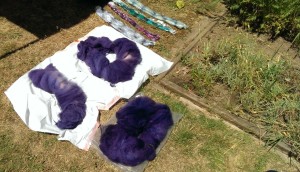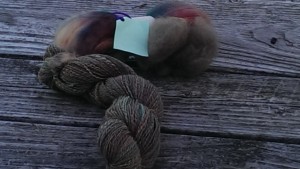The Aurora Colony Handspinner’s Guild had it’s annual Dye Day recently at the Historical Museum in Aurora, Oregon, and I spent the day spinning, observing, and taking a couple of interesting seminars about hand painting yarn and roving, and different ways to spin up said roving. There were lots and lots of kettles going over portable stoves. There was some beautiful kettle dyed fleece:
There was some beautiful kettle dyed hand spun and roving:
Even some dyed sparkly stuff:
I found this to be a nifty idea: hanging smaller bits of fleece or roving to dry in up-cycled onion bags.
There was a demonstration of hand painted roving, using squeeze bottles to apply the dyes to fiber soaked in citric acid or vinegar, and wrapped in plastic to either sit in the sun or go into a steamer. The squeeze bottle recommendation is to source from beauty supply stores for better and more accurate dispensing. The tip on color placement is to keep the same order of color change all the way around the yarn or roving.
There was a neat little seminar about spinning from hand painted roving. Chain, or Navajo plying was suggested as a way to maintain color order, which works especially well when doing an ombré effect. Fractal spinning was also suggested as a way to introduce color shifts when plying. This Knittyspin article is great for explaining fractal spinning: Fractal Spinning.
Finally, there were some samples of hand painted roving divided in half, and one half carded together to make a “neutral”, the other half spun as you normally would, and then these two color ways plyed together. The results of this last technique were pretty interesting, in that it didn’t seem to matter what the original colors were, the blended portion would always coordinate with the unblended portion, and even out and tone done what might otherwise be garish colors. This color way was muted to begin with, but the resulting yarn is quite sophisticated:
It’s always great to get a bunch of people together who share your excitement about fiber. As soon as time permits, I’m going to try my hand at some hand painted roving and experiment with these spinning and plying techniques.







